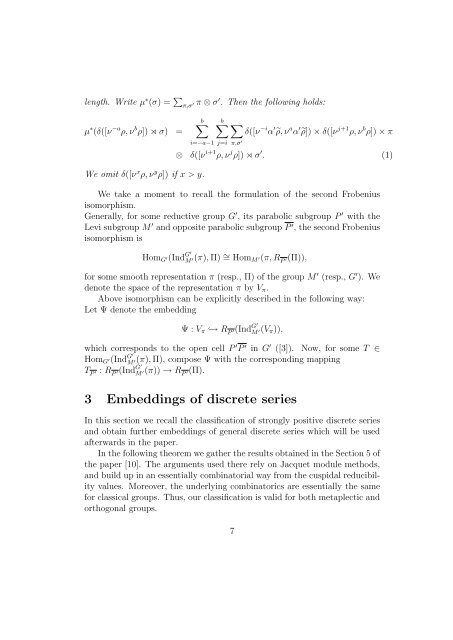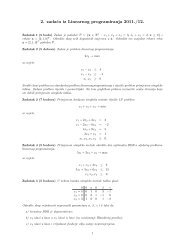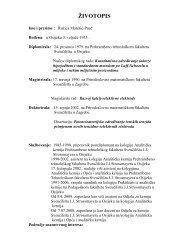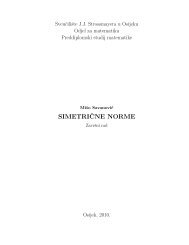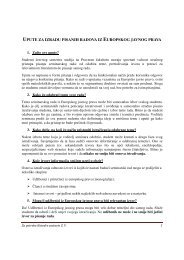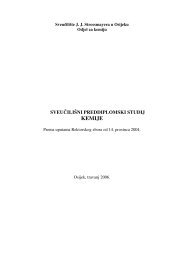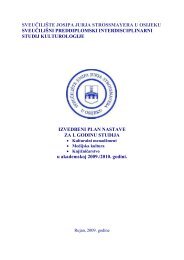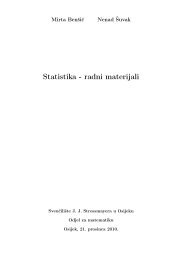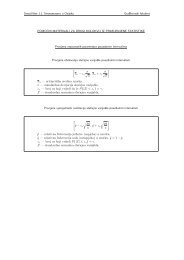GL(n j ) × <strong>Sp</strong>(n − |s|, F ), where |s| = m = ∑ ji=1 n i. Then <strong>the</strong> standardparabolic subgroup <strong>˜</strong>P s <strong>of</strong> <strong>˜</strong><strong>Sp</strong>(n) is <strong>the</strong> preimage <strong>of</strong> P s in <strong>˜</strong><strong>Sp</strong>(n). We have <strong>the</strong>analogous notation for <strong>the</strong> Levi subgroups <strong>of</strong> <strong>the</strong> metaplectic groups, whichare described in more detail in Section 2.2 <strong>of</strong> [5]. The standard parabolicsubgroups (containing <strong>the</strong> upper triangular Borel subgroup) <strong>of</strong> O(V r ) have<strong>the</strong> analogous description as <strong>the</strong> standard parabolic subgroups <strong>of</strong> <strong>Sp</strong>(n, F ). If<strong>˜</strong>P s is a standard parabolic subgroup <strong>of</strong> <strong>˜</strong><strong>Sp</strong>(n) described above, or P s a similarstandard parabolic subgroup <strong>of</strong> O(V r ), <strong>the</strong> normalized Jacquet module <strong>of</strong> asmooth representation σ <strong>of</strong> <strong>˜</strong><strong>Sp</strong>(n) (resp., O(V r )) with respect to <strong>˜</strong>P s (resp., P s )is denoted by R fP s(σ) (resp., R Ps (σ)). From now on, R P1 (π)(χ) (or R fP 1(π)(χ))stands for <strong>the</strong> isotypic component <strong>of</strong> R P1 (π) along <strong>the</strong> generalized characterχ.Also, when dealing with Jacquet modules <strong>of</strong> ω n,r , we write shortly R P1 (ω n,r )(resp., R eP 1(ω n,r )) for R<strong>˜</strong><strong>Sp</strong>(n)×P1(ω n,r ) (resp., R eP 1 ×O(V m) (ω n,r)), following <strong>the</strong>notation from [6].For any irreducible representation π ∈ S ′ (n) <strong>the</strong>re exist an ordered partitions = (n 1 , n 2 , . . . , n j ) <strong>of</strong> some m ≤ n, cuspidal representations ρ i ∈Irr(R ′ (n i )) and π cusp ∈ S ′ (n − |s|) such that π is an irreducible subquotient<strong>of</strong> <strong>the</strong> induced representation ρ 1 × ρ 2 × · · · × ρ j ⋊ π cusp . In this situation, wewrite [π] = [ρ 1 , ρ 2 , . . . , ρ j ; π cusp ], following <strong>the</strong> notation used in [8].Let σ ∈ S ′ (n) denote an irreducible representation. To simplify notation,set P ′ s = P s in orthogonal <strong>case</strong> and P ′ s = <strong>˜</strong>P s in <strong>the</strong> metaplectic one. Weintroduce µ ∗ (σ) ∈ R ′ ⊗ S ′ byµ ∗ (σ) =n∑s.s.(P (k)(σ)),′k=0where s.s. denotes <strong>the</strong> semisimplification. We extend µ ∗ linearly to <strong>the</strong> whole<strong>of</strong> S ′ .In <strong>the</strong> following lemma we recall useful formula for calculations withJacquet modules which is valid in both orthogonal and metaplectic <strong>case</strong>([20, 5]). Let α ′ = α in <strong>the</strong> metaplectic <strong>case</strong>, while in <strong>the</strong> orthogonal <strong>case</strong> α ′denotes a trivial character.Lemma 2.1. Let ρ ∈ R ′ be an irreducible cuspidal representation and a, b ∈R such that a + b ∈ Z ≥0 . Let σ ∈ S ′ be an admissible representation <strong>of</strong> finite6
length. Write µ ∗ (σ) = ∑ π,σ ′ π ⊗ σ ′ . Then <strong>the</strong> following holds:µ ∗ (δ([ν −a ρ, ν b ρ]) ⋊ σ) =We omit δ([ν x ρ, ν y ρ]) if x > y.b∑i=−a−1 j=ib∑ ∑π,σ ′ δ([ν −i α ′<strong>˜</strong>ρ, ν a α ′<strong>˜</strong>ρ]) × δ([ν j+1 ρ, ν b ρ]) × π⊗ δ([ν i+1 ρ, ν j ρ]) ⋊ σ ′ . (1)We take a moment to recall <strong>the</strong> formulation <strong>of</strong> <strong>the</strong> second Frobeniusisomorphism.Generally, for some reductive group G ′ , its parabolic subgroup P ′ with <strong>the</strong>Levi subgroup M ′ and opposite parabolic subgroup P ′ , <strong>the</strong> second Frobeniusisomorphism isHom G ′(Ind G′M ′(π), Π) ∼ = Hom M ′(π, R P ′(Π)),for some smooth representation π (resp., Π) <strong>of</strong> <strong>the</strong> group M ′ (resp., G ′ ). Wedenote <strong>the</strong> space <strong>of</strong> <strong>the</strong> representation π by V π .Above isomorphism can be explicitly described in <strong>the</strong> following way:Let Ψ denote <strong>the</strong> embeddingΨ : V π ↩→ R P ′(Ind G′M ′(V π)),which corresponds to <strong>the</strong> open cell P ′ P ′ in G ′ ([3]). Now, for some T ∈Hom G ′(Ind G′M ′(π), Π), compose Ψ with <strong>the</strong> corresponding mappingT P ′ : R P ′(Ind G′M ′(π)) → R P ′(Π).3 Embeddings <strong>of</strong> <strong>discrete</strong> <strong>series</strong>In this section we recall <strong>the</strong> classification <strong>of</strong> <strong>strongly</strong> <strong>positive</strong> <strong>discrete</strong> <strong>series</strong>and obtain fur<strong>the</strong>r embeddings <strong>of</strong> general <strong>discrete</strong> <strong>series</strong> which will be usedafterwards in <strong>the</strong> paper.In <strong>the</strong> following <strong>the</strong>orem we ga<strong>the</strong>r <strong>the</strong> results obtained in <strong>the</strong> Section 5 <strong>of</strong><strong>the</strong> paper [10]. The arguments used <strong>the</strong>re rely on Jacquet module methods,and build up in an essentially combinatorial way from <strong>the</strong> cuspidal reducibilityvalues. Moreover, <strong>the</strong> underlying combinatorics are essentially <strong>the</strong> samefor classical groups. Thus, our classification is valid for both metaplectic andorthogonal groups.7


